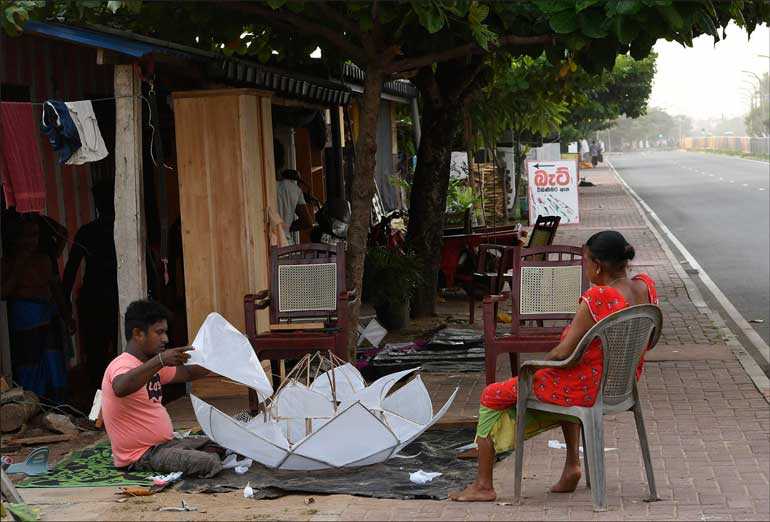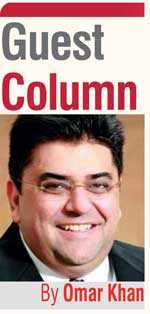Tuesday Dec 30, 2025
Tuesday Dec 30, 2025
Thursday, 7 May 2020 00:00 - - {{hitsCtrl.values.hits}}

So, my most pithy and (relatively) laconic offering in honour of the virtue of simplicity and grace that characterises this blessed season.
Asia population: 4.46 billion
Total COVID-19 deaths in Asia as of 5 May: 20,450
Total new deaths in Asia on that day: 372 (a fair bit less than US)
These are not “panic” or “hide indoors” numbers for this region, no matter how you to try to “spin” them. Being part of the region and enjoying the evidently far lower infectiousness and fatality here, should not mean we outdo the world in factually unsound, exaggerated panic.
What is increasingly clear from simple data
France has now found COVID cases back to December. The first US fatality has now been backdated to 6 February. Ergo, the much maligned, but now seemingly prescient Oxford Study seems increasingly validated. COVID-19 has likely been circulating for some time, and so trying to “stop” an outbreak that has been already “out there” for some time therefore may be absurd. Studies are afoot to review past clinical samples to see how extensive and widespread this might be.
Regardless, antibody tests from Kobe Japan, to Denmark, to Italy, to The Netherlands, to New York, to California, to Florida, show that many more have been infected and recovered, by a very large magnitude (11% to 25% rather than the official tally of 1% or so) than have “tested positive” in the “official count.”
That means again, the infection fatality rate plummets, and we are dealing not with a viral apocalypse but “bad flu.” For anyone outraged by that characterisation, please remember, the 2017-18 flu pandemic, at the upper range was responsible for 575k deaths worldwide.
Healthcare systems and nursing homes
Treating everyone the same is absurd for an illness that overwhelmingly targets the >65 with pre-existing conditions. Why shut down the whole country or economy? Why not let those who can well deal with it and develop immunity, increasingly (though with the best medically advised precautions) run the economy? I repeat, economic meltdown is NOT a viable medical strategy. 90-95% of the deaths in Europe, the US, and by and large everywhere, fall into the above age profile, usually with other contributing factors.
Health care systems were “challenged” in some places, overwhelmed virtually nowhere, with hospital beds now increasingly empty (also due to normal illnesses not being treated with current and future devastating impact possible, and because the “surge” was more hype than happening). In fact, we find COVID-19 is often “nonsocomial” as numerous leading practitioners from the front line have pointed out, meaning an infection people catch in hospitals. Bergamo and Queens, New York, had high rates of infected medical personnel according to John Ionnidis, Professor of Medicine, Epidemiology and Statistics at Stanford, who passed on the virus to already sick patients. Hospital chains of infection with tragic consequences for the most vulnerable have also been cited from Wuhan to Spain. Nursing homes are an overwhelming epicentre of mortality, closed spaces, with inadequate testing, where there is massive exposure. In Sri Lanka, we have seen the impact through a naval base. All such crowded conglomerations of people must have the highest standards of hygiene, caution and testing, imposed.
Crisis of credibility
Fanciful modellers, medical folks who can preside as stand-in “policy makers,” actual policy makers who were terrified by these models and the media alarmism, now have to deal with the one of the most colossally exaggerated forecasts of all time.
The statistical Chamber of Horrors, rolled out, after the fact by an initially reality-dismissing WHO (no human transmission, no need for masks, no need for border controls, sunlight doesn’t help destroy the virus – all incorrect and later revised), and the sombre dialectic of The Imperial College Cassandras, led to panic-stricken policy making, resulting in what one commentator has described as a “vandalistic lockdown” (we went further here in Lanka by deciding we would totally “curfew” and shut down the economy and hope for the best). By what right liberty is indefinitely usurped is a conversation the world will be having for some time. And how readily we are “terrified” into abdicating our “autonomy” is an uncomfortable but necessary meditation.
Professor Isaac Ben-Israel, Chairman of the Israeli Space Agency and the Council on Research Development, showed through publicly downloadable data as I shared before, that the spread of coronavirus falls off dramatically, except for the occasional isolated cluster, after about 50-70 days regardless of degree of lockdown…assuming hygiene, some social distancing, wearing of masks where congested, and similar practices are adopted. 
We have also ignored eminent virologists who have argued that far from being “locked up” we should all be out in virus-killing sunshine and germicidal air (which is why viruses tend to flatten and dissipate each Spring and Summer like clockwork).
The tragic comedy
Taiwan issues a warning in December, WHO opts to turn deaf ears. Rampant propagation takes place in China, an explosive outbreak to be decisively flattened; South Korea virtually loses control, and then in a balletic swivel and with operatic fervour, the world’s greatest demonstration of contact tracing and focused quarantining turns the tide. The SARS “veterans” of SEA, by and large, knew the playbook, on went the masks, in came the hygiene and social distancing and they still in the case of Taiwan and Hong Kong, and increasingly again in Singapore, have functioning economies.
Slow to be ready, Europe either flailed (Italy and Spain) or went very disciplined (Germany, Norway, Denmark), or in one instance, Sweden, has baffled all its critics deciding they would avail of the community trust and resilience of their culture, rather than “lock it up.” New York, global mecca that it has been, was hard hit, and we saw “ventilator panic” until we realised they didn’t help (close to 80% died anyway), and the culprit was more impaired haemoglobin as front-line ER specialists report, not lung capacity per se.
The “probable” COVID deaths are being used to inflate and pad numbers as the desperate need to justify global economic meltdown continues as curves flatten or statistics reduce to a trickle in so much of Asia.
This is far, objectively, from the greatest crisis in our history, nor even remotely the greatest public health crisis in our history. But our crazily extended curfew in Lanka (we must stop arguing it kept cases low, they were already low and deaths did not spike throughout the first 20 days of the curfew, which is the time taken from infection to death, which meant pre-curfew we were not out of control anyway) and the global “lockdowns” (especially the draconian ones, though they seem quite liberal compared to ours), are one of the greatest sustained interferences with personal liberty in modern history.
The former Supreme Court Judge in the UK, Lord Sumption indicates that we should not even add “during peacetime,” as even in wartime, virtually nowhere do we know was it the case that the entire population was confined to their homes, 24/7…unless they had an excuse acceptable to the authorities.
Having done too good a job in terrifying the populace, the issue is, how to ease our way out? Policymakers seem trapped by their own earlier “virus eradication” mania, which is unrealistic and unnecessary. Another strain could emerge next year, and are we on auto-pilot going to demolish economy and society again then, instead of dealing with it, with a combination of medical expertise, personal prudence, the hardiness of the human immunological response, as well as the best overall guidelines we can apply while still living life?
Medical people cannot tell you when to open society. Leaders have to do so. So sheltering behind doctors doesn’t work, as the essence of leadership is to establish and help communicate “acceptable risk” by comparing the entire constellation of risk, including to livelihoods, economic survival, socioeconomic fabric, other needed medical care, psychological and emotional damage and more. Leadership is about managing trade-offs for all of us as individuals too. That is the essence of being alive.
So, worth it now or not?
This again is not a medical judgment as morals, values, economic consequences alongside medical impact have to be factored in.
The statement “life is priceless” and nothing else counts is rousing but is really empty rhetoric. As Wars are fought, insurance is issued based on where we travel, cars are on the roads, pollution kills, and we tolerate and endorse all of it, again because of cost-benefit, because of perceived trade-offs.
Should we impose 15 km per hour speed limits on all roads, highways? We’ll save thousands of lives surely. 4,000 die every few days of pollution in China. Do we shut down cities and retreat to rural communes instead? There are costs and consequences, and we can learn to drive better and put on seatbelts, we can reduce emissions and find better ways of operating cities. It is never “all or nothing.”
And, building on Lord Sumption’s insights, is the life we’re protecting, really the life of sitting cowering indoors as our “way of life” implodes? Life is the ability to create an enterprise, it’s a drink with friends, it’s a busy beach on a glorious day, a family celebration with children and grandchildren, the companionship of friends closer than six feet away. These are not ‘nice to have.’ They are what “life” means to many of us. The ability to head out and explore on a whim among other things. The ability to indulge our tastes, to develop our talents, to interact with other communities. All this is foundational to existence as social beings, and fundamental to our humanity. Yes, we can temporarily suspend such joys. But how “temporarily?” And when and on what basis, and why, do we give the right, in a non-emergency, to have that decided for us without discussion, away?
And people pooh-pooh considerations of money. Well, that’s silly. The fruit stall owner, the Editor of the Daily FT, the Bishop of Colombo, the cashier at Cargills, the bus driver, the bartender, the tea picker and factory manager, all value money, as it symbolises their value and allows them to express their aspirations to some extent. Wages matter, pensions matter, businesses that embody a life-time’s value creation matter, going from a potentially robust economy to value literally thrown away, matters.
This is about security, which without economic solvency doesn’t exist, and sovereignty when we have to strike deals that compromise our national and personal choices, and a future for the children of this blessed land that gets harder each day practically not rhetorically to endow and underwrite and offer. Poverty kills too, and when it doesn’t, it certainly hobbles, undermines, and compromises us physically, emotionally and socially.
And by what right does any State, as is being asked in the US and UK as well, inflict this on us indefinitely, beyond any rational medical justification, when it has no means to compensate us, protect us, or provide alternative livelihood, credit, or liquidity, except through petitioning other governments and donor agencies to take pity on us?
We may have to say, that a society has to be rigorous enough and vigorous enough to have these debates, and to strategically influence its elected leaders to manage the vexing balancing act of comparing different varietals of value, benefit and safety.
In this hallowed and holy season, as Vesak touches Ramadan, and as temples yearn to welcome back adherents, and priests anticipate presiding over mass once more, let us pray for collective wisdom, and the insight and courage to act on it.
Let us refuse to succumb to panic-mongering, and respond to leadership that I’m sure is forthcoming, that invites us to take our destiny back into our own hands.